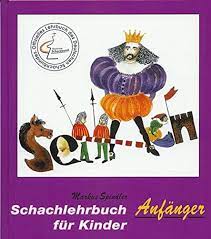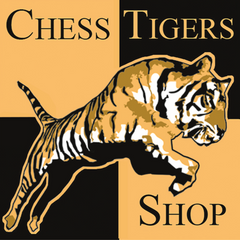
Spindler: Chess textbook for children - beginners
Autor: Spindler, Markus
Verlag: Beyer
Erscheinungsjahr: 2020
Sprache: German
Buchumschlag: hardcover
Seiten: 120
A special children's textbook, easy to understand with clear diagrams. Suitable for self-study and teaching in groups .
Shall we play a game of chess?
A wonderful question. Why? Only those who have penetrated the millennia-old secrets of the royal game, who have been enchanted by the inner logic, the wealth of ideas and also the beauty of chess, will be able to assess this correctly. In our day and age, when televisions and DVD players, computers and hi-fi systems are pushing social gatherings more and more into the background, when Ludo and dominoes sound like terms from prehistoric times, chess has retained its general popularity. Because its unique combination of elements of science, sport and art means it is incomparable to any other game. It is not without reason that the voices calling for chess to be introduced as a school subject are becoming louder and louder, because alongside Latin it is a unique school of logic. Learning through play. It is also not without reason that the game is enjoying increasing popularity as a competitive sport. While 30 years ago the world championship matches were an event that only die-hard fans took notice of, today they have blossomed into a major sporting event, are discussed on the street, and many a Topalov fan is close to having a heart attack when Anand once again turns the wheel around at the last second. But even the non-world champions are no longer outside the public eye. Children as young as ten are already competing in national championships, there is the first European championship for twelve-year-olds, and it is not uncommon for the youth world champion to soon be a contender for the chess throne of the old men.
Until then, it takes a lot of practice and patience. But you also have to use this for maths, for example, which most people don't enjoy. With chess, however, all of this is combined with the joy of playing, the pride of winning a game, and the fun of being with the team. And as scientists have discovered, this game trains our mathematical and scientific skills just as much as a maths lesson. These are already a whole host of advantages, but chess has other things to offer too. Above all, it seems important to me that chess, especially when played competitively in a club, gives us fun, entertainment, and team spirit. A team that works well together will stick together through thick and thin and will certainly not only play chess together, but also go on vacations together, have parties together, and much more. How good it is today, when we have more and more free time, if we also know how to use it sensibly.
I have been working as a trainer for children's groups for several years now, and many of those who have trained with me and travelled around the country are still loyal to this sport today. Some have since moved on to other interests, but I have never met anyone who told me that they no longer play and are sad that they ever got involved in it.
In chess, as in many other sports, children start practicing at an increasingly early age. It is not uncommon for there to be kindergartens that have already included the royal game in their educational program. Those who are at the top of the winners' podium often played their first games at the age of six or even five, and even at the age of four a child is perfectly capable of understanding and practicing the rules of the game. Practice makes perfect...
And so I wrote this textbook primarily for children. In my training sessions, I repeatedly noticed that there was no book or exercise material available that was really made for children and that met the specific requirements that such a textbook must meet. Beginner textbooks, which you can buy everywhere, generally assume that the reader is a potential world champion who actually knows everything and who can therefore be shown a few world championship games after 20 introductory pages, as this is the best way to get the most out of them. But such a textbook is completely useless for methodically structured training; logarithms and integrals are not on the curriculum in first-grade maths lessons, even though the student could learn more from them than from the question of how much 1 + 1 is. So, based on my own experience, I have endeavored to design this book in such a way that it promises an optimal learning effect for children. It is suitable for self-study and can be used as a training material in the chess club or in the school chess group. In all variants, commented games and given rules, I have endeavored to maintain a level that is so far above that of the beginner that he can derive maximum benefit from it. To give a rough estimate: anyone up to the level of the German champion in the age group 12 should be able to read this book with profit. And even though I wrote it especially for children, I still think it is a very good introduction for older age groups who want to get involved with this game.
At the end of each chapter I have added control questions so that everyone can test their knowledge. If you have read the previous chapter, you should not have any insurmountable difficulties with it. I have deliberately refrained from giving the answers, as I think that would tempt you to just look them up too quickly. If you have a particularly tricky question, you can certainly ask your parents, siblings or trainers about it.
To prevent everyone from looking things up straight away, the answers to the control questions are at the end of the second volume.
So we can throw ourselves into the fun. We will learn a lot about our chess army. We should not forget that although many terms come from war, they do not call for violence and injustice; on the contrary, chess is a unique example of how a fight to the death can also be waged peacefully on the board.
Some people may find the book too difficult when they leaf through it. Can a six-year-old child even understand something like that? I would like to say that we often underestimate our children. In any case, this book is a summary of knowledge that should be worked with over a longer period of time. A deeper understanding of many rules and terms will only emerge through practical practice. There are also a lot of tips for this.
Of course, some things could have been left out. But that is the mistake of many textbooks, which omit details that are important for the overall understanding, arguing that a child would not understand it anyway. I believe that a child can understand a lot if they are interested in the subject and it is explained to them correctly! My many years as a chess trainer have shown this. The success of some trainers, who turn beginners into winners of national children's championships within a year, clearly show what potential our children have. We should try to awaken it!
120 pages, hardcover, Beyer , 13th edition 2020, first edition 1996
Sichere Zahlungsoptionen bei uns im Shop
-
Versand mit DHL und DPD
-
Versandkostenfrei in DE ab €50
-
14 Tage Rückgaberecht












